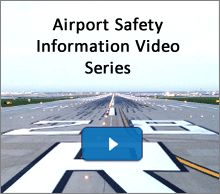Part 139 Airport Certification
On this page …
U.S. airports serving certain air carrier operations are required to be certificated by the FAA. Under 14 CFR Part 139, Certification of Airports (Part 139), the FAA issues Airport Operating Certificates to allow airport operators to serve the following air carrier passenger operations:
- Scheduled passenger-carrying operations of an air carrier operating aircraft with more than 9 seats (with some exceptions for airports in the State of Alaska); and
- Unscheduled passenger-carrying operations of an air carrier operating aircraft with at least 31 passenger seats.
The FAA issues Airport Operating Certificates to airports that comply with safety and emergency response requirements specified in Part 139. Such requirements cover a wide range of issues, including signs, lights and markings, runway safety, aircraft rescue and firefighting, aviation fueling safety, snow and ice control, and wildlife hazard management.
Currently, the FAA certificates approximately 520 US airports. The FAA maintains a list of US airports certificated under Part 139, which is updated monthly (see Part 139 Airport Certification Status List below).
In February 2023, Part 139 was updated to include new requirements for safety management systems (SMS) for certain airports certificated under Part 139. These airports must develop and implement an SMS program to identify and quantify potential hazards and risks and adopt processes to manage them. For more information on these new Part 139 requirements, please go to Safety Management Systems (SMS) for Airports and Airport Projects.
Part 139 Airports
- Part 139 Airport Certification Status List
List of certificated airports by state, name, associated city, and identifier. It also identifies Part 139 classification, ARFF index, inactive status, and large hub airports. This list is updated every 28 days with data pulled from the Airport Data and Information Portal. As of 2/2023, the list also includes SMS Triggers and whether an SMS waiver has been granted.
Guidance
- Advisory Circulars
- Aircraft Rescue and Fire Fighting (ARFF)
- Airport Certification Program Handbook, Order 5280.5
- Application for Airport Operating Certificate, Form 5280-1
- CertAlerts
- External SMS - Part 139 Airports
- Part 139 Presentation: Safety Enhancements Final Rule (2013) (PDF)
- Sample Airport Certification Manual
- Small Entity (SBREFA) Compliance Guide (PDF) | MS Word (1.3 MB)
- Wildlife Hazard Mitigation
Regulations
| Subject/Title | Date |
|---|---|
| Part 139 with Corrections (No Preamble) (updated 4/24/2023) | Includes corrections through 4/24/2023 |
| Subject/Title | Date | Other Formats |
|---|---|---|
| Part 139 Safety Enhancements, Certification ofAirports (78 FR 3311) (PDF) | 1/16/2013 | HTML |
| Corrections to Final Rule (69 FR 31522) (PDF) | 6/4/2004 | |
| Corrections to Part 139 Final Rule (69 FR 24069) (PDF) | 5/3/2004 | |
| February 2004 Part 139 Final Rule (with Preamble) (PDF) | 2/10/2004 | |
| Report to Congress: Economic Impact of Changes to Part 139 on Air Service at Airports Serving Small Air Carrier Aircraft (PDF, 2.9 MB) | 12/2003 | |
| Part 139 Regulatory Evaluation (PDF, 2 MB) | 11/21/2001 |
Contacts
| Type of Inquiry | Contact | Office | Telephone |
|---|---|---|---|
| General | Birke Rhodes | Airport Safety and Operations Division | (202) 267-8027 |
| Specific Airport | --- | Regional Airports Office | --- |
| Press | Crystal Essiaw | Press Office Contact Information | (703) 732-6678 |
| Aircraft Rescue and Fire Fighting | Marc Tonnacliff | Airport Safety and Operations Division | (202) 267-8732 |
| Aircraft Rescue and Fire Fighting | Jim Price | Airport Safety and Operations Division | (202) 267-9085 |
| Safety Management Systems (SMS) | Daria Wonnacott | Airport Safety and Operations Division | (424) 405-7311 |
| Wildlife | John Weller | Airport Safety and Operations Division | (202) 267-3778 |
Regional Supplemental Guidance
Additional guidance on this topic is available for the following regions of the country:
- Central (IA, KS, MO, NE)
- New England (CT, ME, MA, NH, RI, VT)
- Northwest Mountain (CO, ID, MT, OR, UT, WA, WY)
- Southern (AL, FL, GA, KY, MS, NC, PR, SC, TN, VI)
- Southwest (AR, LA, NM, OK, TX)
Contact Us
Diesel Exhaust Fluid and Fuel System Icing Inhibitor Video
Control of Fuel System Icing Inhibitor and Diesel Exhaust Fluid at Airports
FAA Disclaimer: The Energy Institute (EI) produced the video. The EI is a non-profit chartered professional membership body, based in the United Kingdom, that brings together professionals working globally across the energy sector. The body works to address global challenges and uses their skills and knowledge to suggest safety practices that also protect the environment. The FAA encourages users of the aviation system to clearly and safely label Diesel Exhaust Fluid and Fuel System Icing Inhibitor and keep them stored in separate areas, to avoid any accidental mixing of fluids.


